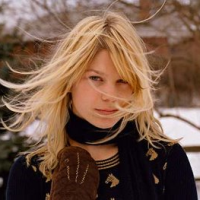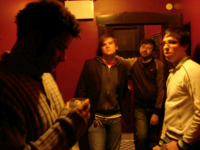
In an exclusive interview,
Aaron Acosta talks about technical aspects of sound design, soundscapes, career ambitions and mentors.
[indiessance]
Your previous album is titled Frequency, Amplitude & Time. How do these three terms relate to sound design? How does each affect how we interpret our surroundings in a unique way?[aaron acosta]
These are the elements that comprise our interpretation of sound. Pitch is how we perceive frequency, amplitude and volume; all sound events happen in time or a duration. I try to manipulate these elements to change the perception of the sound event. For instance, in the CD, songs like
Water Study Song, I take a short sound event, like water dripping, and manipulate the frequency, amplitude and time of the event. So hearing a sound that was originally 3 seconds expanded to 60 seconds, increasing and decreasing the pitch. This allows the listener to discover interesting aspects of the sound.
[indiessance]
According to the Wikipedia, sound design can be understood as the manipulation of audio elements to achieve a desired effect. Is such a desired effect typically a specific emotional response? When you are developing sounds in a track, are you targeting emotions and imagery?[aaron acosta]
I originally did my musical works by accident really. I was trying to get my sound design chops up for film and theatre. I concentrated on things that were evocative of imagery, but open to interpretation. The kind of sound that has a space saved for an image. I like to think of it like some of the listening exercises we had in my classes in college. Being in a dark room and listening to compositions like this, you explore imagery that is half yours and half the composers. I love hearing about the imagery that people who are more creative than I am come up with when they listen to my sounds. I like the idea of using sounds that free people from having to think about
tunes or traditional composition. Because this is unconstrained by an obvious song structure, it allows the listener to create emotions and imagery freely.
[indiessance]
Are there any movies that you would have liked to design the soundscapes for? Are there any movies or novels that helped inspire sound designs? Do you first have a story in mind before you sit down to begin working on each design?[aaron acosta]
So many great movies! I love the Tim Burton films. I really like animation. For a sound designer and composer, you have free range in a way. You are unconstrained by reality, and get to participate in creating reality for the project. Lots of fun.
City of Lost Children is one of my favourites. I would do the sound for that just for fun. I love the imagery, it is very inspiring. I love horror movies. As a genre, horror has sound that directly effects the audience. As far as reading, I am not into novels as much as books. I read really heavy stuff, recently, I have been reading several Taoist works and some books on quantum physics. I don't pretend to understand it, but it does give me inspiration. I kind of say, what would this concept I don't understand sound like? That is where a lot of my work starts. Sometimes I try to communicate an experience of an environment, like
Carlsbad and
Cave from
Wave were inspired by Carlsbad Caverns in New Mexico. I wanted to convey how I felt in that space. Others are about street corners, a snowy field, the ocean.
[indiessance]
These days, popular video games can outsell blockbuster movies. The Halo 3 soundtrack contains a total of 32 tracks - a nice sized project for a sound designer. And that entire soundtrack is filled with great epic soundscapes. Are video game projects just as desirable to you as movie soundtrack projects?[aaron acosta]
For me video games are a little bit more desirable than film! I play video games and love the idea of a being immersed in the story, landscape and emotions of the piece. Video games give you goals that create vested interest in the story and the survival of your character. The time you spend on these games in many cases is the same amount of time you would spend reading a novel, but with a good game you get to experience and participate in the novel. You get wrapped up in the mythology of the world that the designers have created. This is very fertile ground for any sound designer and composer. Games I like to play are the
Final Fantasy series, Fatal Frame, Resident Evil, Silent Hill, Siren. Sound plays a major part in these. Of course with modern technology, these experiences are every bit as satisfying as a major motion picture, in fact I feel more so.
[indiessance]
Brian Eno is known as the father of ambient music, but he was also a record producer, music theorist, etc. What other hats might you be wearing in the future?[aaron acosta]
Right now, I have been giving a lot of thought to installation art. Taking something else from the Eno play book. I would love the opportunity to use my lighting design and set design skills to create a sound design installation that will allow the audience to experience my projects fully. Right now, I have to get off my ass and develop some drawings so I can beg for money and studio space to do that. Something I have never done, but have a great interest in. I would also love to collaborate in such projects. I am also getting my bachelors of education, so in the future, teaching is something I would love to do.
[indiessance]
Have you worked with anyone who has helped shape or develop your sound? Have any particular sound designers influenced your work?[aaron acosta]
So many. In my degree at the College of Santa Fe, I got to work with great teachers that shaped not only the way I work, but the way I look at life. David Dunn and Steven Miller from the contemporary music program at the College of Santa Fe opened me up to electro acoustic music. I could not have developed my first works without them. David Stout at the College of Santa Fe film department was always there for me and developed what I think film sound could and should be. I also find his art installations inspiring. Jim Lyden, and Clark Duncan from the theatre department at CSF allowed me to explore sound design in theatre, and make a ton of mistakes. And in general, I think every director i work with, every project I collaborate on shapes my work and how I see the world a little bit. That's why I love this work. Every project is a chance to change your perception, and learn about people.
[indiessance]
You also compose electroacoustic tracks - a genre that does not have a clear cut definition. What elements do you use in such compositions that might characterize them as electroacoustic?[aaron acosta]
Well, I learned that there were two major camps, the Pierre Schaeffer, Musique concrète camp that takes recorded environmental sounds and juxtaposes them to come up with a composition, and the German Electronic Music that involves purely electronic synthesis of sounds. Modern electroacoustic music is a mix of both of these. I think people who work in this type of music are driven more by sound and our reaction to it. This means you do not feel constrained by song structure, 12 tone equal temperament, or standard music notation. Elecroacoustic music uses electronics to create and/or manipulate sounds in a purely evocative way. Right now the CBC is playing a piece about circuit bending. It is another example of finding sounds and compositions in unusual places. Right now, I think electroacoustic can either be a term that excludes popular music, but is slowly starting to infect it.
[indiessance]
The 60x60 project organizes an annual event - a concert featuring 60 tracks by 60 electroacoustic artists. You have been contributing compositions to 60x60 since the project's inception in 2003. How has 60x60 affected the development of your craft?[aaron acosta]
60x60 is such a great idea. It is amazing to think of the cross section that participate in it. I also love the time limit! It forces you to choose your words carefully. Every year since 2003, I think, this year i have nothing I can submit, but then something strikes me and i am able to create something. I have also been getting inspiration from the shorter pieces to expand upon them and create longer ones. I cant say how much i love the idea of the project. Listening to the cds is like spending 60 seconds in another composers head. It is a great opportunity. Recently, collaborations with video and dance artist is exactly what i love. I love the idea of other artists work being influenced by mine and would like to see more of it in the future. I love to see other's interpretation of their experience of my work.
cd @
cdbaby (wave - aaron acosta)
cd @
cdbaby (frequency, amplitude and time - aaron acosta)
profile @
myspacehome page @
aaronacostasamples:
wavemp3 @
aaronacosta (carlsbad)
mp3 @
aaronacosta (deception)
mp3 @
aaronacosta (far)
mp3 @
aaronacosta (wave134)
samples:
frequency, amplitude & timemp3 @
aaronacosta (traffic)
mp3 @
aaronacosta (fire study song)
mp3 @
aaronacosta (beat 61203)
mp3 @
aaronacosta (ddd3)
mp3 @
aaronacosta (medical)
mp3 @
aaronacosta (earth study song)
mp3 @
aaronacosta (nebulous)
review @
smother.net

















